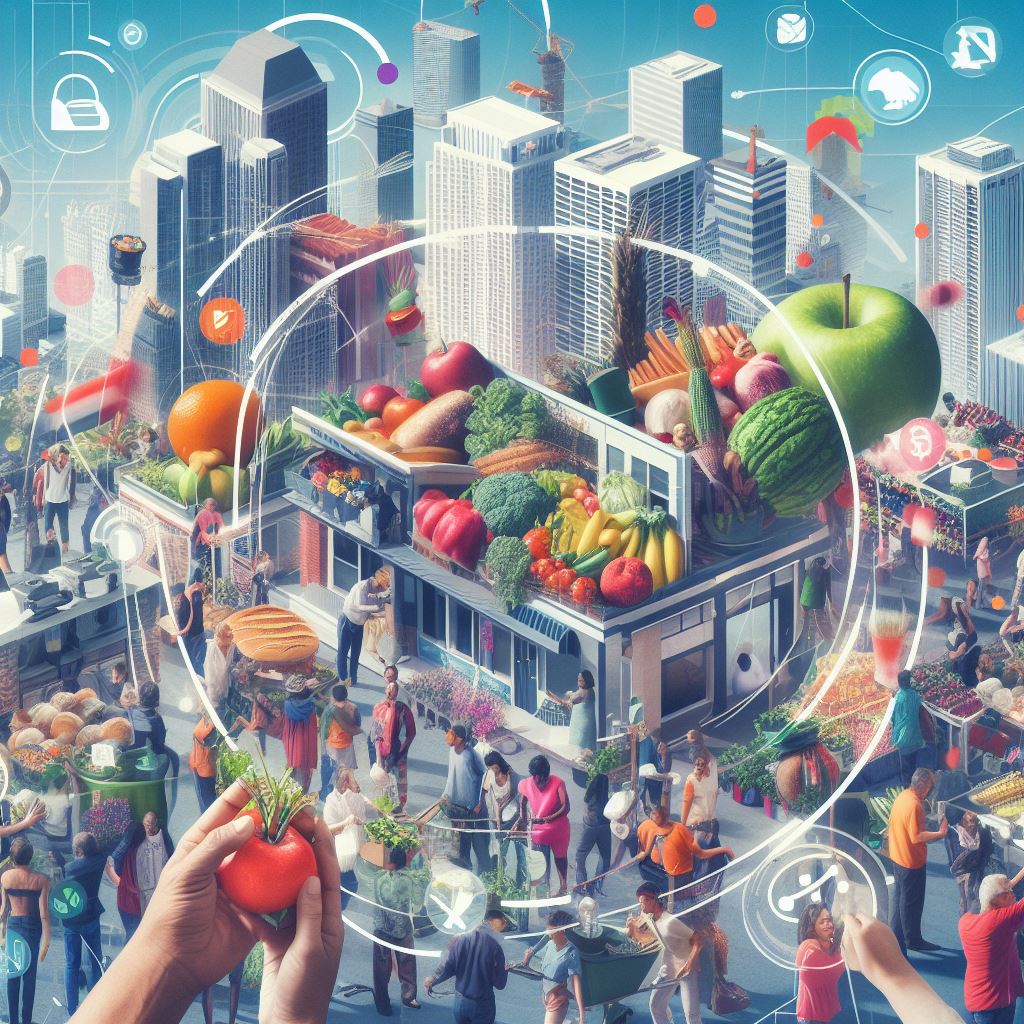Why Does Government Food Assistance Boost the Economy?

Imagine a world where hunger diminishes, poverty rates decrease, and communities thrive. Well, brace yourself, because government food assistance programs have the power to make this a reality.
By boosting consumer spending, reducing poverty rates, stimulating economic growth, promoting healthier communities, and ensuring food security, these programs prove to be a catalyst for economic prosperity.
So, let’s dive into the data and uncover the remarkable impact government food assistance has on our economy.
Key Takeaways
- Government food assistance increases consumer spending power, leading to a boost in economic activity.
- Assistance benefits spent at local grocery stores and farmers’ markets support local businesses and create jobs in the retail and agricultural sectors.
- Food assistance programs help reduce poverty rates and improve social well-being by allowing individuals to meet their basic needs and allocate limited resources to other essential expenses.
- Access to nutritious food through food assistance programs leads to improved overall health outcomes and reduced healthcare costs.
Increasing Consumer Spending
When you receive government food assistance, it directly increases your consumer spending power. This boost in spending has a significant impact on the economy as a whole. According to a study conducted by the U.S. Department of Agriculture, for every dollar spent on food assistance programs, there’s an estimated $1.50 to $1.80 increase in economic activity. This multiplier effect occurs because when you have more money to spend on food, you’re able to purchase additional goods and services, stimulating demand and creating a ripple effect throughout the economy.
Furthermore, government food assistance programs not only increase consumer spending but also support local businesses and job growth. When you spend your assistance benefits at local grocery stores and farmers’ markets, it helps sustain these businesses and allows them to hire more employees. In fact, a report by the Economic Research Service found that every $10,000 in food assistance benefits generates approximately six jobs in the retail and agricultural sectors.
Reducing Poverty Rates
Government food assistance programs help reduce poverty rates by providing individuals and families with the necessary resources to meet their basic needs. These programs, such as the Supplemental Nutrition Assistance Program (SNAP), play a crucial role in alleviating poverty by ensuring that vulnerable populations have access to nutritious food.
According to data from the United States Department of Agriculture (USDA), SNAP lifted approximately 2.6 million people out of poverty in 2019. This represents a significant impact on poverty reduction, as it equates to a 3.3% decrease in the poverty rate. Furthermore, the program also reduced the severity of poverty for many individuals, allowing them to have a more stable and secure living situation.
By providing assistance to low-income individuals and families, government food programs not only help meet their immediate food needs but also alleviate the financial strain that comes with food insecurity. This, in turn, allows them to allocate their limited resources to other essential expenses, such as housing, education, and healthcare.
Moreover, reducing poverty rates through food assistance programs has positive ripple effects on the economy. When individuals have access to nutritious food and aren’t burdened by extreme financial hardship, they’re better positioned to participate in the workforce and contribute to economic growth. Additionally, lower poverty rates lead to reduced healthcare costs, decreased crime rates, and improved overall social well-being.
Stimulating Economic Growth
To further boost the economy, food assistance programs not only reduce poverty rates but also stimulate economic growth by increasing consumer spending power. By providing low-income individuals and families with access to nutritious food, these programs improve their overall well-being and allow them to allocate more of their limited resources towards other essential needs, such as housing, healthcare, and education. This increase in spending power has a ripple effect on the economy, generating positive impacts across various sectors.
A study conducted by the United States Department of Agriculture (USDA) found that every $1 spent on food assistance programs generates $1.50 to $1.80 in economic activity. This is due to the multiplier effect, which occurs when the initial injection of funds leads to subsequent rounds of spending. As recipients of food assistance spend their benefits at local grocery stores and farmers markets, the demand for food products increases, leading to higher production and sales. This, in turn, supports job creation and boosts revenues for businesses in the food industry.
Moreover, food assistance programs not only benefit the food sector but also have wider economic implications. The additional consumer spending resulting from these programs stimulates demand for other goods and services, which supports businesses across various industries. This increased demand leads to job growth and higher wages, ultimately driving economic growth at the national level.
Promoting Healthier Communities
By improving access to nutritious food, government food assistance programs contribute to the promotion of healthier communities. These programs play a crucial role in addressing food insecurity and ensuring that individuals and families have access to the necessary nutrients for optimal health. Research has shown that individuals who receive food assistance are more likely to consume a variety of fruits, vegetables, and whole grains, leading to improved overall health outcomes.
When individuals have access to nutritious food, they’re less likely to suffer from chronic diseases such as obesity, diabetes, and heart disease. This not only improves the quality of life for individuals but also reduces healthcare costs for the community. In fact, a study conducted by the Harvard School of Public Health found that every dollar spent on food assistance programs resulted in a reduction of healthcare costs by $10.55.
Additionally, promoting healthier communities through food assistance programs can have long-term benefits. Children who have access to nutritious food are more likely to perform better academically, attend school regularly, and have improved cognitive development. This sets them up for success in the future and contributes to a stronger, more productive workforce.
Ensuring Food Security
To ensure food security, it’s essential for individuals and families to have reliable access to an adequate and nutritious food supply. Food security refers to the availability, accessibility, and affordability of food for all people at all times. It’s a fundamental aspect of human well-being and plays a crucial role in promoting health, reducing poverty, and fostering economic development.
Here are three key points to consider:
- Economic Impact: Food security is directly linked to economic growth and stability. When individuals and families have access to a reliable food supply, they’re better able to maintain good health, which enhances their productivity and earning potential. This, in turn, contributes to overall economic growth and reduces the burden on healthcare systems.
- Social Stability: Food security also plays a vital role in promoting social stability. When people have access to adequate and nutritious food, they’re less likely to experience hunger and malnutrition, which can lead to social unrest. By ensuring food security, governments can help create a more stable and harmonious society.
- Sustainable Development: Achieving food security is closely linked to sustainable development. By promoting sustainable agricultural practices and investing in agricultural infrastructure, governments can enhance food production, reduce waste, and protect natural resources. This not only ensures food security for the present but also for future generations.
Frequently Asked Questions
How Does Government Food Assistance Specifically Target Low-Income Individuals and Families?
Government food assistance specifically targets low-income individuals and families by providing them with financial support to purchase nutritious food. This helps to alleviate food insecurity and improve the overall health and well-being of those who need it most.
What Are the Long-Term Effects of Government Food Assistance on the Overall Economy?
Government food assistance has long-term effects on the overall economy. It boosts consumer spending, stimulates local businesses, and reduces poverty rates. These positive impacts create a ripple effect, leading to economic growth and stability.
Are There Any Potential Drawbacks or Unintended Consequences of Government Food Assistance Programs?
There can be potential drawbacks or unintended consequences of government food assistance programs. It is important to analyze the long-term effects on the overall economy to fully understand their impact.
How Do Government Food Assistance Programs Ensure That Eligible Individuals Receive the Support They Need?
To ensure eligible individuals receive the support they need, government food assistance programs have streamlined processes, such as income verification and application review, which help identify and provide aid to those most in need.
How Does Government Food Assistance Contribute to Reducing Healthcare Costs in Communities?
Government food assistance contributes to reducing healthcare costs in communities by providing access to nutritious food, which can improve overall health and prevent chronic diseases. This, in turn, leads to lower healthcare expenses and a healthier population.



